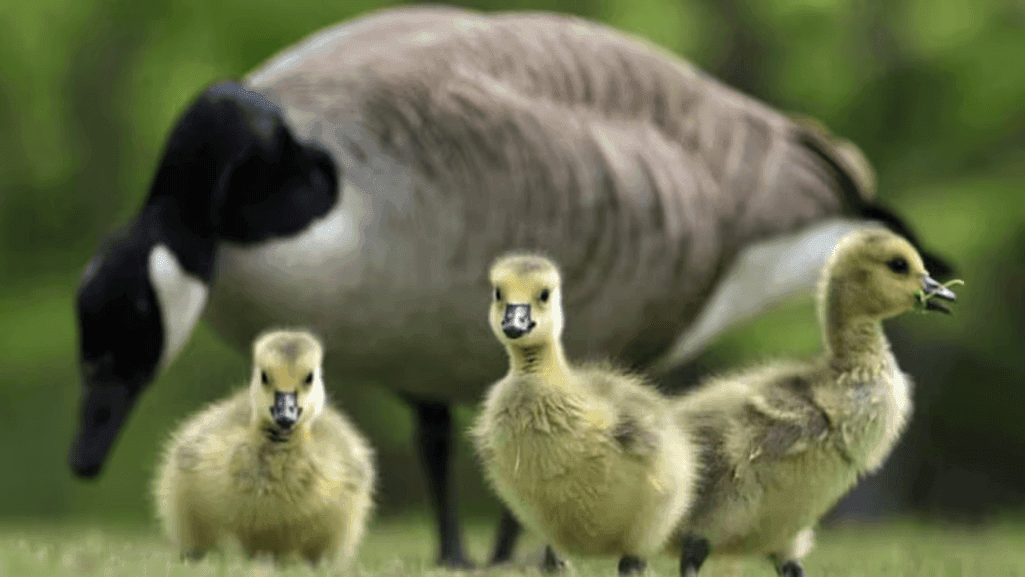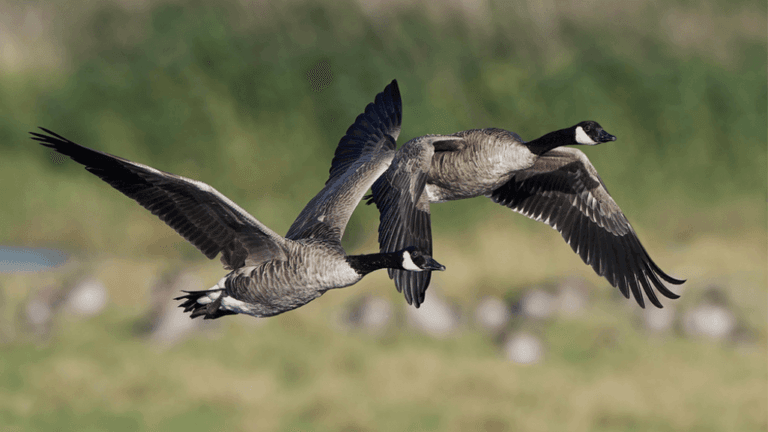It’s important to know what baby geese, or goslings, need to eat to grow well. They have different food needs at each stage of their life. A good feeding plan should be rich in nutrients and balanced.
Goslings need a starter feed with 20-22% protein in the first three weeks. It’s key to use NON-medicated feed to keep them healthy. This avoids harm from medicines.
When goslings are 3 weeks old, their diet should have 15-16% protein. This helps them grow at a slower pace. It’s also time to start grazing and add whole wheat to their diet.
By 17 weeks, goslings can eat a mix of layer feed and wheat, or just wheat. In winter, they might also eat sea kelp or hay. This is because greens are harder to find in cold weather.
Key Takeaways
- Initial feed for goslings should be high in protein and non-medicated.
- Adjust protein levels in the diet as goslings grow and their growth rate changes.
- Fresh greens and grazing are necessary for goslings’ diet after 3 weeks of age.
- Continuous provision of fresh water is critical to prevent choking.
- Supplementation with niacin and the provision of grit are essential for goslings’ bone growth and digestion.
- Gradually transition goslings to an adult diet which includes free-ranging for grasses and weeds.
- During winter or when access to greens is limited, alternative sources like sea kelp and hay become important.
Understanding the Nutritional Needs of Baby Geese
In the world of waterfowl, the nutritional requirements of young geese, or goslings, are critical for their healthy development. Proper nourishment in the early stages of life sets the foundation for their future growth, health, and behavior. Providing the right nutrients for baby geese is integral to nurturing these young birds.
Key Nutrients Required for Growth
The initial weeks of a gosling’s life are critical. They need a high-protein diet to support their vigorous growth rate. Protein is not the only nutrient on the priority list; a balanced intake of calcium is essential for strong bone development, as they don’t need to produce eggshells at this stage. Niacin, a vital B vitamin, also plays a significant role in their overall development, supporting functions like bone growth and metabolic processes.
Importance of a Balanced Diet
A well-rounded goslings diet includes a variety of essential vitamins and minerals to culminate in optimal health. It’s important to start with a diet that mirrors the natural intake they would glean from their environment. In the wild, geese can extract nearly 80% of their nourishment from grasses and aquatic plants, which are rich in micronutrients beneficial to their growth. When feeding baby geese in a more controlled setting, replicating this diet with commercially available feeds ensures they receive adequate nutrition. Proper growth feeds will contain adjusted levels of protein: typically starting from 20-22% in the initial weeks then tapering to 15-16% as they mature.
Natural Foods Found in the Wild
In exploring the waterfowl feeding habits, we see how goslings eat natural foods. These foods help them grow strong and healthy. They learn to find food in their habitat, which is key for their future.
Goslings love to eat fresh grasses and leaves. These are easy to digest and full of nutrients. Eating these foods helps them grow physically and mentally.
Grasses and Leaves
- Common grasses include sedges and clover, which are plentiful in spring and summer.
- These grasses are full of vitamins and minerals, giving goslings a balanced diet.
Aquatic Plants
- Aquatic plants add to a gosling’s diet, including rushes and aquatic weeds.
- These plants offer nutrients not found in grasses, making them very beneficial.
These plants do more than just feed goslings. They help waterfowl fit into their ecosystems well. Goslings learn to find food early, making them fit in perfectly.
If you want to learn about feeding practices or raise waterfowl, mimic their natural eating habits. This keeps goslings healthy and supports nature.
Knowing about goslings’ diet and feeding habits helps conservation. It ensures these beautiful birds do well in their natural homes and beyond.
Commercial Feed Options for Baby Geese
Choosing the right commercial feed is key for baby geese to grow strong and healthy. It’s important to know what to look for in duckling food and what do baby geese eat. We’ll look at the best commercial feeds for goslings and how to pick the right one.
Types of Pellets Available
Starter crumbs and grower/finisher pellets are made for young waterfowl like goslings. They have more protein and niacin to meet their needs. The protein in these feeds ranges from 7.5% to 19%, depending on the gosling’s age.
- Mazuri Waterfowl Maintenance, with 14% protein, is great for its balanced nutrients. It also floats on water, reducing waste.
- Purina Duck Feed pellets have 19% protein. It’s best to mix it with lower protein foods like whole oats for geese.
Choosing the Right Formulation
Choosing the right feed depends on the goslings’ growth stages. Starter crumbs are best from hatch to 3 weeks. Then, switch to grower/finisher pellets. This helps with balanced growth and prevents too much weight gain.
- For goslings from hatch to 3 weeks: Use high-protein starter crumbs (18-19% protein).
- After 3 weeks: Switch to grower/finisher pellets with 15-16% protein for proper development.
Feeding habits change with the seasons. In winter, goslings need more feed and fresh produce. In spring, use specialized feeds like Mazuri Waterfowl Breeder.
Following these nutritional guidelines and choosing the right duckling food is vital. It ensures baby geese grow into healthy adult birds.
Supplementing with Vegetables and Fruits
Feeding baby geese with vegetables and fruits boosts their nutrition. It adds variety to their diet and gives them the nutrients for baby geese they need to grow.
Safe Options for Baby Geese
It’s important to give baby geese safe and healthy foods. They love to eat garden greens like kale, broccoli, and spinach. But, spinach should be given in small amounts because it can affect calcium levels.
Fruits like bananas, watermelon, and berries are also good. They give vitamins without too much sugar. These foods are not just treats; they help make the diet of baby geese richer and promote health.
Avoiding Toxic Foods
Some foods are bad for baby geese. Avoid giving them avocado, white potato peels, and green tomatoes. Apple seeds and some berries can also harm them.
Knowing which foods are safe is key to keeping your geese healthy. By choosing the right foods, you help them stay well and enjoy their growth.
Feeding Frequency and Amount
Feeding baby geese right is key for their health and growth. Knowing how much and how often to feed them is important. This ensures they get the right food as they grow.
In the first weeks, feeding baby geese means lots of meals, day and night. This helps them grow fast. They need lots of protein to develop well.
Ideal Portion Sizes for Different Ages
- 0-3 weeks: Starter feed rich in protein is always available.
- 3-8 weeks: Start adding grass and reduce commercial feed.
- 8-16 weeks: Mix commercial feed with grass and whole wheat.
- 17 weeks and beyond: Eat mostly grass, with little extra feed in winter.
Recommended Feeding Schedule
Having a set feeding schedule is important for goslings’ health. At first, they need food all the time. As they get older, they eat less often and more grass.
- Early stages: Food is always available.
- Later stages: Eat twice a day, with time to roam and graze.
Following these tips and watching their goslings diet closely is key. Good spacing, clean water, and the right food are essential. For more tips on raising geese, check out expert resources on goose care.
Common Feeding Mistakes to Avoid
When talking about what do baby geese eat, it’s key to avoid common mistakes. It’s not just about giving them food. You also need to know how to feed them right.
One big mistake is giving them too much bread and cereals. These foods are not good for them and can cause health problems. Bread, for example, has too little protein and can lead to angel wing. This makes it hard for geese to fly.
Overfeeding and Its Consequences
Feeding baby geese too much can cause them to grow too fast. This can lead to angel wing, where their wings can’t fly. It’s important to feed them the right amount of protein and avoid foods like bread. For more tips on feeding goslings, check out this guide.
Ignoring Water Access
Another mistake is not giving goslings enough water. Water is important for digestion and to prevent choking. Make sure they always have fresh, clean water, even when they eat dry food.
By avoiding these mistakes, you can help baby geese grow healthy. If you want to learn more about caring for them, this resource is great. It has lots of useful information on the early stages of caring for waterfowl.
Spotting and fixing these feeding errors early is vital. It helps keep baby geese healthy and happy. This sets them up for a strong life in their natural or adopted homes.
Transitioning to Adult Goose Diets
It’s important to know how to switch from feeding baby geese to their adult diet. A careful guide helps goslings grow well. This ensures a smooth transition, just like their soft feathers.
Gradual Diet Changes
At first, goslings diet needs a lot of protein to grow fast. They live in a warm brooder, between 90° and 95°F. But, as they get older, they need less care and food.
The brooder gets cooler by about 10 degrees each week. This helps them adjust to room temperature. It’s also important to have fresh water always available. When they go outside, watch them to avoid overeating and to see how they interact with nature.
Maintaining Nutritional Balance
As goslings become adults, they need less commercial feed like Mazuri Waterfowl Starter. They start to eat grasses and greens, just like they would in the wild. In cold months, they might need extra grain to stay healthy.
Remember, goslings need clean, dry bedding, like pine shavings, when they’re young. As they grow, it’s key to manage their diet well. This keeps them healthy and happy with their flock.












